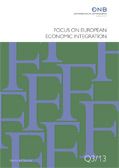Focus on European Economic Integration Q2/17
 OeNB
OeNB
- Erschienen:
- Juni 2017
 OeNB
OeNB
Call for entries: Olga Radzyner Award 2017 (PDF, 164 kB) Focus on European Economic Integration Q2/17 en 02.06.2017, 00:00:00
Call for applications: Visiting Research Program (PDF, 167 kB) Focus on European Economic Integration Q2/17 en 02.06.2017, 00:00:00
Developments in selected CESEE countries: Solid economic momentum on the back of vivid consumption dynamics (PDF, 1,3 MB) en 02.06.2017, 00:00:00
Outlook for selected CESEE countries: Investment-driven upswing in CESEE and comeback of growth in Russia (PDF, 465 kB) en 02.06.2017, 00:00:00
How financially vulnerable are CESEE households? An Austrian perspective on its neighbors (PDF, 924 kB) Fessler, List, Messner. We employ newly available microdata to analyze household indebtedness and financial vulnerability in selected CESEE countries. The new 2014/15 wave of the Household Finance and Consumption Survey (HFCS) covers Slovenia, Estonia, Hungary, Latvia, Poland and Slovakia. Austrian banks have significant exposure to households in many CESEE countries, and the number of nonperforming loans is rather high in some of them. Our goal is to provide a clear picture of household vulnerability and its potential impact on financial stability and thus to allow for thinking in evidence-based scenarios. We focus on the joint distribution of debt and collateral and add several measures of financial vulnerability, such as loan-to-value, debt-to-income and debt service-to-income ratios. In addition, we employ econometric methods from the decomposition and policy evaluation literature to decompose differences in vulnerability measures between countries into two parts: one that is attributable to different borrower characteristics and another that is down to other external factors, such as differences in banks’ behavior across countries. Our results show that households are particularly vulnerable in Latvia and Hungary and that variations in household composition have different effects on vulnerability across the countries covered. en household-specific property prices, mortgages, banking sector, Austria C81, D31, E21, E31, G21, O52, R31 02.06.2017, 00:00:00
The relevance of remittance inflows to CESEE countries: evidence from macro- and micro-level data (PDF, 1,1 MB) Raggl. Focus on European Economic Integration Q2/17 In this study, a combined analysis of micro- and macro-level data on remittances is used to shed light on the relevance of such transfers in Central, Eastern and Southeastern European (CESEE) countries. In the early and mid-1990s, and more recently in the context of EU accession, CESEE countries experienced considerable out-migration, and remittances have become an important source of foreign exchange in these countries. Against this background, this study examines the relevance and nature of remittance inflows to CESEE. To this end, both the dispersion of remittances across individuals in a country (based on microdata from the OeNB Euro Survey) and the average amount received per recipient (estimated by combining micro- with macrodata) are assessed. By relating these two dimensions of remittances descriptively, we examine differences across countries and changes over time. en remittances, emigration, intensive and extensive margin, CESEE F24, F22, O57 02.06.2017, 00:00:00
HFCS-CESEE Workshop: How to use survey data for analyzing financial stability in CESEE countries (PDF, 194 kB) en 02.06.2017, 00:00:00
The OeNB’s 80th East Jour Fixe: Bulgaria and Romania – 10 years after EU accession (PDF, 196 kB) en 02.06.2017, 00:00:00
Statistical annex (PDF, 371 kB) en 02.06.2017, 00:00:00